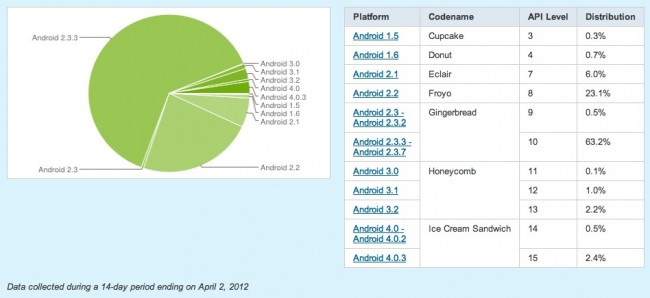
I really despise this time of the month. Whenever the Android team updates their distribution chart, a barrage of posts from the tech world scream out our favorite word and argument all over again: fragmentation. It never fails. It gets so old, but these industry analysts and pundits can’t help themselves. Do we believe that there is some form of fragmentation in Android? Obviously there is or we wouldn’t have a chart like we do above. Is it a death sentence or end of the world as many seem to make it out to be? Not for a second.
As you can see from the chart, only 2.9% of Android devices today, run Ice Cream Sandwich, the newest version of Android. While that’s frustrating to a point, we know that carriers and manufacturers are feverishly preparing updates for many of their handsets, all of which should be here shortly. This is simply the way Android is and arguably, the way it was meant to be.
It’s a free and open platform. Google made it this way on purpose. They want manufacturers to take it, tweak it, customize it, and then sell it to consumers. They want different experiences to be created and for OEMs to innovate. If they didn’t, they would have already laid down the law and closed off everything or started selling the platform. Do we see OEMs really complaining all that much? Android helped revive most of their depressing sales goals over the last 2 years and helped some of them become global smartphone giants.
“But fragmentation is so bad!” Is it really? Android is everywhere. It has taken over the mobile world and is dominating in market share. How is it so bad? Sure, there are times when an app here or there doesn’t work but on the newest version of Android. And yes, we all wish we could have updates to the new version of Android the minute Google announces it. That’s just not the way this platform will probably ever work. I hate to say it, but get used to it. Android is doing fine the way it is. Is there room for improvement on the update front? Of course there is – Motorola, Samsung and HTC could all be faster. And by all means, they are getting faster. With Gingerbread last year, it took 6-7 months before OEM skinned updates started happening. With ICS, it has taken all of 3-4 months for some.
I’m just saying for the 1,000th time, that fragmentation as an issue is not anywhere near the level that some of these people would have you believe. Only tech geeks and bored journalists truly believe it to be a problem. Go ask your aunt with the Incredible 2 if she’s mad about not having ICS yet. Chances are, that you mentioning it is the first time she’s heard of it. Just give her a phone that works, at a reasonable price and that has a ton of apps on it – exactly the way Android is.
This post was last modified on April 3, 2012 11:27 am
